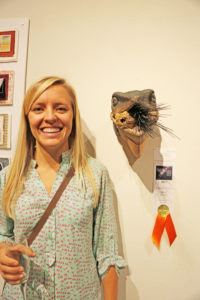
First Place Winner: Heather Hillard, sculpture, “Inevitable”, a commentary on climate change.
Second Place Winner: Ling-Yen Jones, necklace
Third Place Winner: Michael Henderson, graphite drawing, “Eagle Mountain Railroad”
Judges Choice Award: Paula Ray Power, photo, “Farrier’s Door, Ireland”
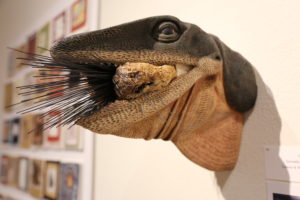
The Gualala Salon is made possible by the generous donations of
Sharon Nickodem, Roland Stoughton, Miriam Owen, Bonnie Saland, and other notable sponsors.
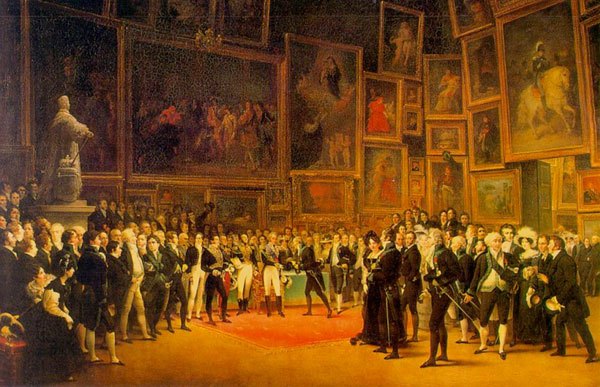
Gualala Salon & Salon des Refusés: It is the fifth anniversary of the Gualala Arts Salon and it is looking to be a special celebration and exhibit. The annual Gualala Salon & Salon des Refusés is a juried and judged fine art exhibit showcasing outstanding visual art and artists without regard to the type of media.
To celebrate the Salons’ fifth anniversary, this year’s reception will be a catered affair (in addition to the champagne and cake from the Let Them Eat Cake Fine Arts Decorating contest that happens on the same evening) and all the awards have been increased by 20 percent.
In addition, there will be a judging trio for this very special Salon made up of artist Karen Shapiro and art collectors April and Ronald Dammann (see bios below).
The annual Salon & Salon des Refusés is the largest exhibit at Gualala Arts aside from Art in the Redwoods; it has the largest number of entries of any other open call show and fills both the Burnett Gallery and Elaine Jacob Foyer. The Salon is sponsored by generous donors; not by Gualala Arts or the North Coast Artists’ Guild. Many artists save their best new art for this exhibit, as the Salon has gained much notoriety as a judged show by well-qualified people in the arts one that provides significant awards.
As per tradition, the judges decide what artwork is accepted into the Salon exhibited in the Burnett Gallery. The art not juried into the Salon by the judges is displayed in the Salon des Refusés (Rejected) located in the Elaine Jacob Foyer. Thus, all artwork submitted into the show will be exhibited at Gualala Arts. Which artists are selected into the Salon is a tightly kept secret until the opening night.
As in previous years, significant prizes will be awarded to first, second and third best art piece. With the increase, this year’s monetary awards are first prize of $1,250, second prize of $1,000, and third prize of $750. In addition, the People’s Choice awards in the Salon des Refusés were also increased to first prize of$125, second $100 and third $75. The award for Emerging Artist Under 18 years of age is $100.
The original Salon des Refusés was an art exhibition that took place in Paris in 1863, showing works that had been rejected by the official Paris Salon conservative judges. These judges represented the French Academy and were advocates of traditional, orthodox style of painting and sculpture. In 1863, they rejected almost 3,000 pieces of work which resulted in loud protests by the artists. Emperor Napoleon III, ever sensitive to public opinion, ordered a new exhibition to be organized – dubbed the “Salon des Refuses” – in order for the public to judge the merits of the artwork themselves.
In the spirit of the original Paris Salon des Refusés, all visitors will be able to vote for the “People’s Choice” awards. In fact, many artists prefer to be selected as a “reject” to receive the public’s opinion!
History and inspiration of the Paris Salon
Gualala Salon has its origins in the annual Paris Salon sponsored by the French government and the Academy of Fine Arts. The Salon began in 1725 and became a showcase of the best academic art. A medal from the Salon was assurance of a successful artistic career; winners were given official commissions by the French government, and were sought after for portraits and private commissions. In those days exhibiting in the Salon was one of the only means artists had of marketing their work and therefore exclusion from its annual selling exhibition threatened their reputation and livelihood.

In 1748, a jury of awarded artists was introduced. From this time until 1890, the Salon was considered the greatest annual or biannual art event in the Western world. The Salon exhibited paintings floor-to-ceiling and on every available inch of space. Printed catalogues of the Salons are primary documents for art historians. Critical descriptions of the exhibitions published in the gazettes marks the beginning of the modern occupation of art critic.
The Gualala Salon and corresponding Salon des Refusés are inspired by the original Salon des Refusés held in 1863 of the refused artwork by the official Paris Salon. The exhibition was ordered by Emperor Napoleon III after the outcry caused by the number of rejections. The increasingly conservative and academic juries were not receptive to the new Impressionist painters, whose works were usually rejected, or poorly placed if accepted. Some were rejected from the ‘official’ exhibition because their works were considered by the committee too subversive and some even thought that these artists posed a danger to society.
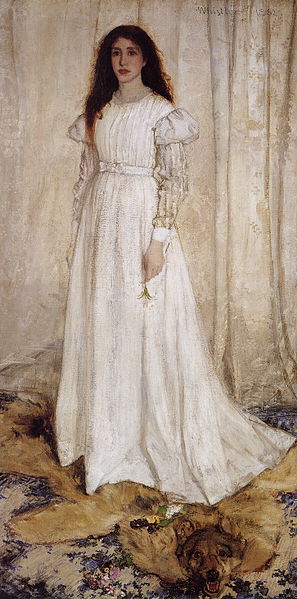
In 1863, artists and their supporters protested vehemently after so many paintings were rejected; only 2,217 paintings out of the more than 5,000 submitted were accepted. Eventually to quell the furor, Napoleon came to view the rejected works and then asked the committee to reconsider its selection. When they refused, he decreed that the public be given the opportunity to view them in a rival exhibition and a tradition of Salon des Refugés was born.
More than a thousand visitors a day visited the Salon des Refusés. The journalist Emile Zola reported that visitors pushed to get into the crowded galleries where the refused paintings were hung, and the rooms were full of the laughter of the spectators. Critics and the public ridiculed the refusés, which included such now-famous paintings as Édouard Manet’s Déjeuner sur l’herbe and James McNeill Whistler’s Symphony in White, No. 1: The White Girl.
Claude Monet, Camille Pissarro, Pierre Auguste Renoir, Alfred Sisley, Edgar Degas, Paul Cezanne, and Berthe Morisot were also participants in the first Salon des Refugés. This exhibit legitimized the newly emerging forms of avant-garde art, and paved the way for the even more shocking style of Impressionism. Ironically the artists included in the officially sanctioned 1863 Salon have completely disappeared and their work remains in obscurity.
We respect the Gualala Salon judge’s decisions and understand that being selected to exhibit in the Gualala Salon Exhibition is a great honor and privilege, and we also understand that the Burnett Gallery space is limited and a lot of good artwork has to be rejected. We want those works to still be on show throughout Gualala Arts Center as part of the Salon de Refusés. We hope this rather novel approach will appeal to the judge, the artists and to the audience!
This Year’s Judges:
5th Annual Gualala Salon Judges – Special Anniversary Judge Trio
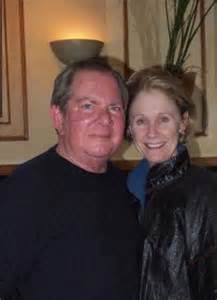
Karen Shapiro, contemporary ceramic artist
Ronald Dammann, gallery president & art connoisseur
April Dammann, writer of many scripts & books
We are so excited to have the husband and wife team of April and Ronald Dammann return with Karen Shapiro as a special anniversary judging trio this year’s Salon and Salon de Refusés.
Art historian April Dammann studied at the Art Institute of Chicago, UCLA, the University of Rochester (M.A., French literature) and the Sorbonne. She was a longtime member of Los Angeles County Museum of Art’s Art Museum Council, while pursuing an award-winning writing career for television, film and the stage. April grew up in Hollywood (with one stretch in Hyde Park, Chicago), the daughter of a radio/TV personality dad and a showgirl-turned-politically active mother.
Ron Dammann, president of Stendahl Galleries, and April went to Hollywood High and have been going steady, ever since. Ron graduated from the University of Arizona with a B.A. in Anthropology/Art History. His specialty is Pre-Columbian art from Mexico and Central America and, over a span of 44 years, he has developed a clientele for California impressionist paintings of the 1920s, as well as for Western artists of later periods. Active in the Los Angeles art community, Ron has served three terms as president of the Art Dealers Association of California and is currently chairman of the Ethnic Arts Council of Los Angeles.
For more than 20 years, Ron enjoyed Senior Member status with the American Society of Appraisers in fine arts. He and wife April are avid collectors; their Northern and Southern California homes are filled with art representing diverse genres and styles. For years April has written for radio, television, motion pictures and the stage. Currently she is producing plays in Los Angeles.
This year Ronald Dammann and his wife April, the gallery’s archivist, sold the historic Hillside Avenue Stendahl Galleries and property in Hollywood and moved to Mendocino County, California. In 2016, the Stendahl Galleries celebrated one hundred five years of continuous operation in Los Angeles—a remarkable feat. Three generations of dealers, have been instrumental in forging an aesthetic identity for the West Coast and beyond: a legacy of unsurpassed connoisseurship. Visit aprildammann.com and stendahlgalleries.com for more information about the Dammann’s work.
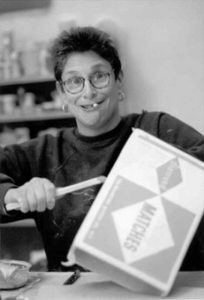
Karen Shapiro’s first recorded attempts at artistic expression were at the ripe age of 5 years or so when she painstakingly painted the adobe brick walls surrounding her house in Tucson. The records of these attempts are the scratchy old home movies taken years ago – the painted images being executed in nothing but tap water and disappearing instantly in the Arizona sun. Years later Karen majored in art in high school where she began working in clay and continued in this medium as a design major in college. After college and continuing until a couple years ago, my medium changed drastically to a more edible artform in the shape of a long, hard career as a pastry chef. Today she is out of the kitchen and back into the ceramics studio where she is finding great joy in working in a sculpture style which is new for her.
Now Karen finds herself jumping around from vegetables to nail polish bottles and lipsticks, to crayons and on and on…and in addition to these wonderful objects she has also discovered the raku kiln. The excitement of reaching into a red-hot environment with tongs, of the flaming bucket, even the choking smoke, and finding results she never dreamt of – always changing, always so much to learn – has given her back an enormous energy, appetite and passion for her work. Visit rakukaren.com to see more of Karen’s work.
2017 Gualala Salon 2017-Gualala-Salon-registration-web
 Gualala Arts Promoting public interest and participation in the arts since 1961
Gualala Arts Promoting public interest and participation in the arts since 1961